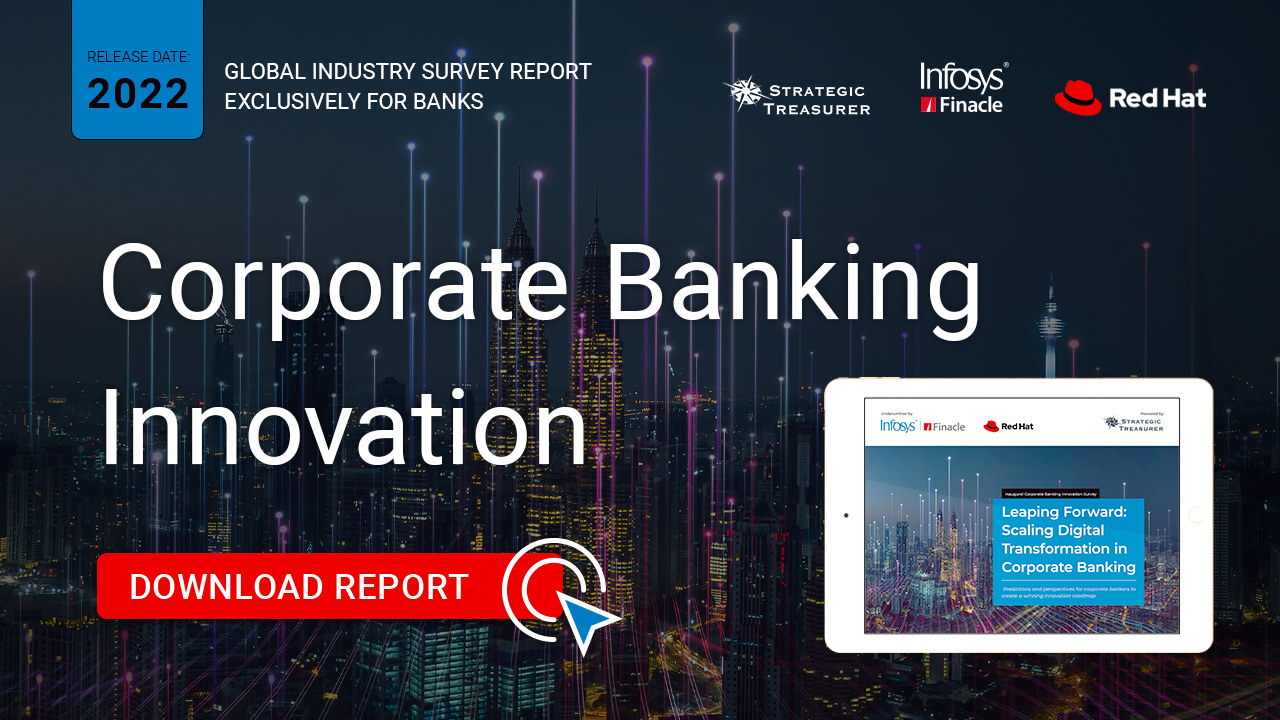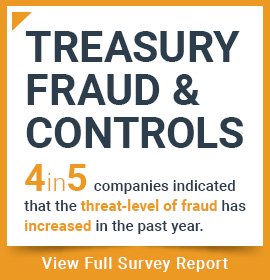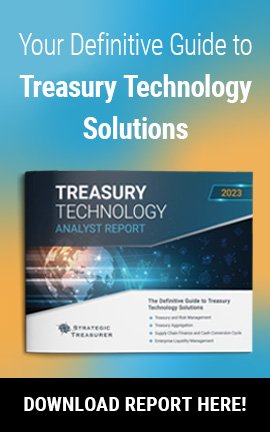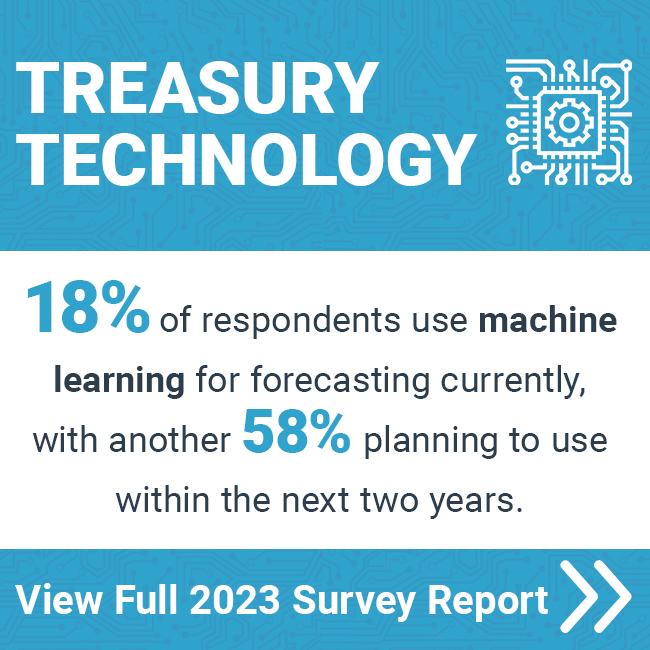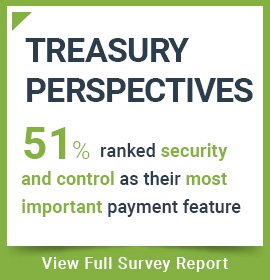
Episode 194
Corporate Banking Digital Transformation Status: Underway, Future, Myth
In this episode, Host Craig Jeffery leads a discussion with senior leaders in the corporate banking industry who are driving digital transformations and innovation strategies from across the globe in London, Singapore, and Hongkong. Craig is joined by Sanat Rao of InfoSys Finacle, Vincent Caldeira of Red Hat, and Venkat ES of Bank of America. Listen in to hear more on technology, APIs, and corporate banking innovations.
Request the Corporate Banking Innovation report here.
Host:
Craig Jeffery, Strategic Treasurer


Speakers:



Subscribe to the Treasury Update Podcast on your favorite app!
Episode Transcription - Episode # 194: Corporate Banking Digital Transformation Status: Underway, Future, Myth
Announcer 00:04
Welcome to the Treasury Update Podcast presented by Strategic Treasure, your source for interesting treasury news, analysis, and insights in your car, at the gym or wherever you decide to tune it. In this episode hosts Craig Jeffery leads a discussion on the importance of relationship management and innovation strategies as well as corporate banks lagging adoption of modern technologies. Craig is joined by treasury professionals from across the globe in London, Singapore, and Hong Kong. Listen in to this discussion on digital transformation.
Craig Jeffery 00:48
I want to welcome each of you to today’s Treasury Update Podcast on corporate banking digital transformation. Let’s begin with an introduction from Infosys Finacle. Sanat, would you give the audience a quick introduction of your your role?
Sanat Rao 01:04
Hi, everyone. My name is Sanat Rao, I’m the Global Head and CEO of Infosys Finacle, based in London, and very much looking forward to this conversation with Venkat, Vincent, and the rest of the group.
Craig Jeffery 01:16
So good to have you. And Vincent from Red Hat. Will you introduce yourself as well?
Vincent Caldeira 01:23
Sure. Hi, Craig this is Vincent here. I work as a chief technologies for financial services at Red Hat. I’m based in Singapore, but I work globally, we have some of our strategic customer. They also partner like Infosys Finacle.
Craig Jeffery 01:37
Excellent. Thanks, Vincent. And from Bank of America, we have Venkat. Venkat. Would you also introduce yourself?
Venkat 01:44
Hi, everyone, I’m Venkat based out of Hong Kong, I manage the tertiary product for the Asia Pacific for Bank of America as part of global transactions.
Craig Jeffery 01:54
It’s very good to have you here as well. So we have Atlanta, London, Singapore, and Hong Kong. That’s the magic of modern day technology. Let’s begin with digital transformation and sound. And Sanat, I’m going to call a new first and then Vincent and Venkat. But let me give you a little bit of background on digital transformation. So just to set the stage, you know, before the pandemic factors such as digital technologies, competition that’s new and nimble. And as well as demanding customers that were very digitally savvy they were making for new orders and new arrangements in corporate banking pandemic has done if it’s done anything, it’s accelerated the digital transformation and adoption in this in this in this domain. So in this context, Sanat, if you could share some of your views on what we need to consider about a comprehensive digital transformation, what’s what’s the key for corporate banking business success.
Sanat Rao 02:54
As you rightly said, the pandemic has indeed accelerated digital transformation. Before I touch about corporate banking, I think it’s fair to say that given the relative ease with which the world adapted to a new way of working, and indeed embraced all manners of technology, I’d like to believe that it is indeed a turning point in terms of the way we will adapt us and indeed get comfortable with technology as a whole. Because what the last 24 months have proven is that without technology, there’s practically nothing that you can do. That said, I think when we look around the world of banking, and particularly corporate banking, the truth is that corporate banking, in some ways, lagged behind consumer banking as far as digital transformation is concerned. And particularly when you look at the fact that many banks had started transformation in some manner or the other. But I think it took them time to arrive at a stage of digital maturity. And this was corroborated, I think, through the annual research that Infosys Finacle carries out. In fact, in our research, only 26% of the banking executives who are interviewed said that their organization had deployed digital transformation at scale. Now, given that we are recording this, at a time when hopefully the worst of the pandemic is behind us, I’d like to believe that that pace of adoption will certainly increase. And there’s no reason to believe that corporate banking will be left behind. When we look at areas such as bank connectivity, channels, deposits, payments, strains of them, I think, at various different stages of maturity, if you like, and indeed, even when you look at the fact that between large banks and regional banks, there are different degrees of adoption. I think while these numbers may prompt us to think that corporate banking, corporate banks are not digitizing fast enough. The truth is that digital transformation and particularly banking innovation that comes out of that it is an ongoing journey. It’s not. It’s not a one size fits all approach is not something that happens overnight. And indeed, given the dynamic environment we’re living in the goalpost is moving frequently. And therefore it isn’t the nature of this transformation to take a bit of time. I think if I were to summarize all of this, my view is that banks need to commit the required number of years and a comprehensive approach. And essentially, I think we see five areas in which banks need to succeed. First and foremost, I think they need to maximize digital customer engagements to drive growth. Without digital customer engagements, very little can be achieved. The second is that while there’s certainly a quest for growth, let’s not lose sight of the fact that banks need to operate efficiently and therefore digitizing and automating ubiquitously to cut costs is going to be equally important. As the pandemic has shown, there are organizations who adopt and use technology. And there are organizations who use it to differentiate. Towards that end, I believe that innovating continuously to create new value, and to stay ahead of competition will certainly receive increased trust going forward. And the last two points I want to just put on the table is there is no dearth, and there’s no shortage of new technologies around us whether it’s cloud, API, all manners of artificial intelligence, all of them, of course, allow banks to unlock new possibilities. So I think that will be another area. And finally, let’s not forget that banks, and particularly the corporate bank, they need to focus on leveraging talented teams and driving a particular culture in the organization to unlock true potential. And I think as we’ve seen in the recent past, even as many economies have begun coming out of the pandemic, addressing people related matters, and ensuring that you get the best out of the talent that’s available to you, is as important as any other element of your business strategy. So these are the five areas, Craig, that I think banks will focus on, the corporate banks will focus on, and I remain very optimistic that the best is still ahead of us.
Craig Jeffery 06:54
It sounds like it’s we’re still in sort of early stages, but there’s a significant amount of growth and momentum. Moving forward. And let’s expand this discussion. Vincent, I’ll call on you to weigh in or expand. And I think that Sanat has said or anything you want to add to the conversation,
Vincent Caldeira 07:11
it’s a very comprehensive explanation by Sanat, but one point I’d like to jump on is maybe difficulty to scale digital transformation. So in my experience, I think one key issue and I would say cause for failure and digital transformation program is this expectation that you can look at technology based innovation to transform your business model, which definitely is not enough, it takes your people it takes to change your ways of working as well. And then the the other aspect of it is the change in mindset. You know, I think something that has damaged quite a lot, the mindset of technology manager in the past is this concept that we have all heard of bimodal IT which seems to imply that you know, I can have an IT team that is doing some innovative system roll out, trying new technology, and when I’ve got these huge IT organization at the back, just making sure that things don’t you know, get broken and that is actually a very inappropriate image, right. Because if it was an organization you need to transform is that everybody has to roll in the same direction and drive towards the same type of goal. So anybody in your IT organization wherever we are, we are looking after, you know, the systems of record, the legacy systems, or the people building the new business capability, actually takes everyone to make the changes and pull the boat together to achieve real sustainable digital transformation.
Craig Jeffery 08:49
Vincent, thank you, getting on the same page. Really appreciate your comments there. Venkat, I want to bring you in on this as well as we begin our discussion on digital transformation. Any additional thoughts from from you?
Venkat 09:02
It’s a journey right? Digital transformation, as we always say from a bank perspective, it is it’s a journey. So, the average any bank would look at a digital transformation is basically discover, differentiate, and deliver. What I mean by that is, start with good kills. Processes that are manual paper based which can be eliminated brings in operational efficiencies, which Sanat was alluding to. Second differentiate by embracing innovation and data driven insight, hammered the data for business intelligence, decision making. Try to see how you could improve speed to market and future proof your business. And last but not the least, is focus on the modern risk management. Never lose sight of cybersecurity, ESG, and sustainability goals, which becomes a key consideration in your digital digital transformation journey.
Craig Jeffery 10:08
So we’re going to start shifting now to the second section, which is we moved from digital transformation to business model innovation. Business models are rapidly changing. And corporate banking business is an exception. And Sanat, I’m going to, I’m going to call on you for the question as this comes out. So the future really seems to be about building a platform business by tapping into new and diverse partner networks as opposed to a single monolithic structure. This is geared towards driving innovation within a larger ecosystem. So how will this influence the success of the corporate banking business? What is your approach to enabling platform based journeys, as opposed to what came before?
Sanat Rao 10:51
I’m glad we are talking about business model innovation, because I think it would be a fallacy to believe that just by using technology, institutions can make a difference. At the end of the day, there are different ways of using technology. And it has to obviously fit in with the business strategy of the organization for it to be a true differentiator. And towards that end, as you rightly pointed out, business model innovation is going to become very important. When we look at the landscape, if you like of corporate banking businesses, globally, traditional corporate banks have seen their competitive advantages, whether it’s the reach in the market, the product choice, the expertise is available, the customer base, a lot of that has eroded over a period of time for a variety of different reasons, that has been made in financially more difficult with macroeconomic environment. Such as you know, we are operating in a regime with very low interest rates, there pandemic induced defaults, I’m sure, and these will actually start showing up I think, in the next 12, 18 months, all of these are putting a strain on the profitability of banks. And then you have the non bank players, you know, coming in and using technology and disrupting the market, with innovation with a variety of new business models and differentiating themselves. I think towards this end, staying relevant and adapting to the rapid change, and indeed, managing uncertainty becomes very, very important. You know, you refer to the pipe platform business, I think banks will look at the legacy pipeline based business model, where every bank, every corporate bank used to manufacture and distributors own products through its own channels that will break down and it will all be led through an ecosystem of partners, and indeed, maybe even competitors, where you compete in one area and collaborate in the other area. So we carried out a business model innovation report earlier survey last year. And I think the survey, not surprisingly spotlighted this particular trend as well. And this is a survey that was carried out with a variety of banks in different parts of the world. If I were to sort of summarize this, I would say that the survey sort of categorize business model innovation in eight different categories. There’s digital only banking, of course, where you know, you don’t resort to brick and mortar, it’s completely digital end to end. There’s what what we see as banking is service. There’s embedded finance, which is becoming more and more popular in many different parts of the world. You’ve got digital financial advisors, and you know, finance marketplaces, if you’re all familiar with marketplaces, and we use marketplaces, very often in our day to day activities, you’re gonna have finance marketplaces, you’re gonna have banking, curators, banking industry, and all of these coming in different avatars. Now, not to say that all eight models that have spelled out here are going to be equally important. Indeed, many of them may not necessarily be as successful as we think we expect them to be. But I think based on our early experience, we would say that banking as a service, marketplace, banking, and the whole concept of industry utilities, will really lead the trend in the early stages, as we look at the year 2022 and beyond. Thereafter, it’s anyone’s guess. But I think just the fact that there are so many different models available, in some ways, points to the fact that there is huge opportunity for an institution that wants to focus on this area.
Craig Jeffery 14:12
Now let’s, let’s shift our conversation to digital engagement and experiences and Venkat I’ll call on you first and then we’ll go to Vincent and Sanat on this but let me set the let me set the question up. So being digital at core really provides the foundations for this digital first corporate banking agenda. And banks are and try to strive for delivering experiences that are fully digital not transformed to analog or, or manual. Here’s the question Venkat given that no two corporates are exactly alike, their expectations aren’t the same. What are some of the new possibilities in digital engagement and experiences? And how should corporate banks strategize about this? What should what should be their reaction?
Venkat 14:56
Yeah, the core is how got to kind of meet the customer needs, right? That drives everything that a bank has to do. And one should bank actually what’s happened on the retail banking space. The major trend that we see is consumerization of the wholesale bank, where corporate clients are now expecting the same kind of experience that they get in their personal lives when interacting with their data banking operations. So with that, what’s happening is, the engagement with a corporate client for a bank has always been one a challenge, given the legacy processes legacy technology, infrastructure. And the opportunities are enormous, right with endless technologies, like what Sanat and Vincent were highlighting earlier with API’s with Blockchain with artificial intelligence, machine learning. So the focus has to be with a clear purpose. That’s what we do, in our bank, create an intelligent Treasury with a motto powered by people and driven by technology. The key aspect here is how do we enable that engagement, which transforms their operational processes, their business processes, and results in something a robust growth. That’s how we define how to enable the business, the coding of clients to transact anywhere, anytime, using a variety of methods of payments and E commerce. I’ll just outline into five different aspects of how the constant digital engagement experience for clients, when the key operative word is more superior client experience to the cycle of the relationship. First and foremost, how to establish the connectivity with the client, the onboarding process, in quite a few markets. Still, it’s heavily paper driven most of the emerging markets, given the local regulations, given the kind of market practices, given the kind of more stays at which the banks operate in that market. That embalming is paper, how do you transform that and facilitate a paperless onboarding for corporate clients create a seamless experience, leveraging the new concepts like E signatures, document exchange, clarity and market specific local laws, rules and regulations, KYC everything in a digital form. Second, once a client is going through the process of establishing the financial transaction and transacting with a client, how do you redefine the efficiency by simplifying the client’s business environment to create a seamless efficiency in the treasury operations, processing in terms of scale five, real time 24 by seven, providing self servicing tools seamless across all the devices? That’s one of the examples we have is the cash per app, which is really no operator, anytime, anywhere, right. Another example that I can provide is is providing them a emission learning this tool for managing the receivables to reconcile automatically. How do you leverage the data with actionable insights so that the bank can provide advisory expertise, innovation and data to help times to optimize their business and enable them to make strategic decisions? What is the value added here? How do you leverage the research based data analytics for any industry or competitor insights, drive business intelligence and enable decision making simpler and faster for the clients to make their business grow and prosper? The next one and key ingredient in this whole digital experiences? How do we mitigate the risk banks deal with corporate clients large values of transactions, especially on the b2b side, money moving cross border trade transactions happening globally. All this has to come with an element of utmost trust, which forwards customers to comfort on the cybersecurity as more and more world becomes digital. Cybersecurity is the center of the plate. And how do we make their businesses more secure, reliable and resilient. And last, but not the least is while the world is focused on the sustainability goals and ESG activities, how digital could be leverage for clients to achieve their ESG and sustainability goals. Before everything, the metaverse is a thing, we’re already in a virtual worlds like this podcast, right? And boundary now think beyond physical constraint and redefine that digital marketing and servicing models to be truly global, driven by the strength of their platforms, with a constant engagement. And again, I repeat the superior client experience throughout that engagement with that life lifecycle relationship between the corporate client and the bank.
Craig Jeffery 20:37
Thank you, Venkat. Yeah, now, Vincent, would you have any comments on digital engagement experiences?
Vincent Caldeira 20:45
So I mean, Venkat, definitely provide a lot of great use case and example of how customer engagement has evolved specifically in the, in the context of corporate banking. Now, if I take my technology lens, I would say, the revolution here, what we are looking at is, but the new generation system of engagement, actually try to build meaningful customer engagement for what I call data driven digital insight. So what’s really at stake here is, in the past, banking institution, they used to have what I what I see as very application centric architecture, you basically build systems, but you don’t have to perform a specific function or purpose. Today, what we see is banks are actually building capabilities that are more data centric. Instead, they’re trying to see how they can leverage more data about the customer. And not just data they acquire in the context of the financial services they provide, but also data from the partner, or data from the customer themselves, who are willing to share to provide more meaningful and personalized service. So take an example. Recently, I was actually engaged with a banking customer that was, you know, building a digital capability directly that SME banking, specifically. And what we found out is SME owner, typically, they don’t really have access to cash management solution. So something quite smart that we did is we actually use the bank’s existing cash management capabilities and model predictive models, to basically make the solutions available to realize me customer using payables and receivables data, and basically helping to forecast cash management needs and provide adapted financial service to the customer. So of course, the way that the tool is actually provided, it actually opens an avenue for discussion and to provide a much more meaningful engagement to the customer, which is very different from the usual harassment of a I’m just getting you to sell you a product. In this case, I actually know that you need this service because I have underlying data that has driven the proposal.
Craig Jeffery 22:59
Excellent. Thank you, Vincent, and Sanat I’ll give you the last word on digital engagement and experiences.
Sanat Rao 23:07
Well, actually, there’s a little to say beyond what Venkat and Vince have already outlined, I think we’ve touched on all the main points, I’ll just make two very brief points. Both of them refer to data and insights, I’ll just add to that, saying that making data work for the enterprise as a whole will be crucial. Otherwise, we run the risk of banks continuing to operate in silos just like they have in the past. And the second point is we’ve sort of mentioned embedded finance in the past, the fact that embedded finance allows, you know, the opportunity for corporate banks to build data and technology infrastructure and allow for connectivity via API’s, and sort of embed that within their clients’ business applications, I think that will be a big differentiator in terms of providing life, right kind of customer experience. So these are the two points. But otherwise, I think we’ve touched on all the main points from what Venkat and Vincent have already said.
Craig Jeffery 24:02
Thank you. And now we’re going to shift to technology. And we’ll begin with you Vincent and then move to Venkat. So, as the pandemic, the crisis that we see there, subsides or, or disappears or fades to, you know, something that’s sustainable and absorbed, many companies will continue to adapt and work remotely. We’ve seen numbers based on the industry of 40 to 50%, living in a hybrid or continue to remote environment. Here’s the questions, and Vincent, you can answer either or all of them, but I’ll just put the questions out there together. So how important is it for banks to adopt smart business processes, which are paperless, have minimal human interventions, and are fully digitized? So that’s one. The other is, what’s been your experience driving digital first operations in corporate banking, and what’s been the adoption or affinity to advanced technologies. So, Vincent, if you’d start us off?
Vincent Caldeira 25:03
Yes, sure. So I think the first question is back to what we were discussing earlier about successful digital transformation. I think if, as a bank, you start to really look at how you transform your customer engagement and your customer experience, but you do not actually start to look at how you also improve your internal process, your delivery, when you pretty much doomed to fail. The reason is, as you generate new business efficiently for your customer, your middle and back office are not going to be able to deliver the same speed at which, you know, your your frontline business has evolved. So what I have seen my experiences on the technology angle, is that there is as much adoption of new technology to make internal processes and back office more efficient to actually support and sustain the evolution in digital services. So that’s how crucial it is, if you don’t improve your process and your efficiency at the back. I mean, you could be in the situation, but all these great new business that you’re acquiring, it also needs you to recruit hundreds or 1000s of people doing manual work, you know, over paper and and an efficient process just to actually support your business. So that’s not what we want to see. So that’s kind of for the most part. And of course, technology is not everything, but it helps focusing specifically on technologies that we deem as, you know, very mature and widely adopted in the space of corporate banking, probably starting with the front end, anything around API development and API management platform we discuss this, you know, in terms of data integration. First thing is, organizations need to be better at making data work across multiple systems and break data silos. So internally, API helped to achieve just that, which is to interconnect systems more easily. But also looking at integration with external partner, whether it’s you know, fintech ecosystem of solutions, or new distribution partner, or basically, it requires a way to share, you know, integration capability with external developer who need to be able to build solution in a kind of standardized way. So that’s really where APIs I’ve been crucial in facilitating this, this process of linking together capability and application. Now if I go a little bit deeper, we have also seen a huge trend in adoption of what we call advanced level integration. So here more looking at when you are moving to real time digital system, facilitating interaction, one of the key chains you have to really support is that now all data has to be integrated in real time as well. And data movements are a lot faster. And they are a lot more complex, because you now have hundreds of services that potentially can react to any event in the customer journey. So the way you can actually promote this is this technology that is event driven, they basically help you to publish a huge amount of information for the broader set of capability and service in the organization to consume them. And so there’s a term that I particularly like here, which is the term of composability. When you actually adopt this technology, it’s a lot easier to compose business solutions by selecting various existing capability across your system, and just package them together into a new solution. So that’s very key to auditing new products with new digital offering. And, you know, obviously, scaling the business. Now, last but not least, let’s not forget our friends at the back who are managing the IT infrastructure, and are trying to cope with all the great new business, that the bank is acquiring. How to help those people? So here, really the trend is people talk about cloud adoption, I think he’s a little bit more focused on this, right? If you just go to the cloud with your good old legacy system, let’s be honest, not much impact on operations, no improvement in scalability. So cloud itself doesn’t actually solve this issue. What solve this issue is the adoption of software practice, that lets people build software into small package components, and deploy them easily on cloud and allow the cloud to scale. So here we talk about container technology. It’s very complex for the non technical people. But it’s not actually that complex. It’s just a way to package software and also to add dependency together and to facilitate the deployment. So now if you can facilitate the deployment of software, it means you can make change faster, it means you are testing faster, it means you are holding faster, then it also means that once you deploy those container on any cloud service, when the cloud services can help you to scale your system a lot more easily, without having to rely on manual inputs from an open letter to do this. So this is critical, because as I mentioned earlier, we know you need all parts of the organization to to move together. And that includes the people in the back who are looking at the load on the system.
Craig Jeffery 30:32
Some of the things that I took away from that is you have to have faster development deployment to support the business, which is looking at faster processes more real time. So nothing seems to be getting slower. Venkat, could you weigh in here as well, on the technology front,
Venkat 30:49
Nothing is getting slower. On the contrary, everything is getting faster, right? Everything is real time in nanoseconds, whether it is real time information, or real time liquidity or real time payment, you name it, everything is moving into real time. And to that extent, the only way it could make it happen is technology of all the aspects that Vincent already touched upon, right. Two key things when it comes to technology from the bank perspective, as Senat was alluding to earlier, the common challenges most of the global banks, we find is the legacy platform, but at the same time, the emerging new technologies. So the solution is one, we can wait for a word for technology to transform our we can leverage the partnerships, like good friends, from Infosys, or from other fintech partners that we find everywhere, who have that expertise, who can bring in that latest technology who has that nimble footed, faster to market kind of solutions. So to that extent, technology is an enabler. But to your point earlier, the business processes need to adopt to the tuning the technology to deliver the solutions. And also the adoption, which Vincent was talking about. How do we make that happen, right? Today, we have front end platform and the mobile app for clients to kind of transact anything that they would like to do we have seen 55% increase year on year, and again, accelerated by the pandemic, in terms of our Cash App. The payment approvals on cash crop has gone up almost 120%. And the kind of solution that we deliver, during the business processes is enabling us to kind of not deliver solutions faster, quicker. And that’s reflected in simple things like how do you kind of know, make sure clients can deliver all the paper based solutions, which hitherto they were doing in a traditional mode in a digital way. Most of the emerging markets that you see today, across the world, with forex and capital controls, comprehend, still need to rely a lot on paper based documents for supporting either a bill of exchange or supply chain, our payments are even for that matter credit. Someone was talking about embedded credit delivery, right. So to that extent, technology becomes a key enabler, but reorganizing and reengineering the business processes, to suit the market need and also the client crushes specific requirements is a key to success or here. There is no two ways about it. And for that to happen, everything that is available on the table today, whether it is machine learning, whether it’s artificial intelligence, what it is blockchain technology, whether it is API’s. All of this needs to be leveraged to make sure that how we kind of the word superior client experience that we were talking about earlier.
Craig Jeffery 34:18
Excellent Venkat. I’m going to call on you again for the next section. So so just be ready. I’m not picking on you. But we’ve already started talking about API’s and some of the concepts of open banking. Let me set it up before I get to the questions, Venkat. But API’s and open banking are rapidly achieving relevance in corporate banking, as Vincent had, had discussed his foundations for much of much of what’s been talked about, you know, as an example, banks are setting up API gateways to help clients with easy and quick access to their banking information and enables them to perform transactions in real time. So here are the questions. What are some of the unique possibilities And how is your bank driving innovation in the space? And what are the key expectations from your clients, Venkat.
Venkat 35:07
Yeah, to get started, we are in the forefront in terms of adopting API’s, one of the key enablers to deliver solutions as I was talking about earlier. What is API’s do? It is just being a real time bridge between different applications, right? It opens up an endless stream of possibilities. It allows information to be presented to clients in their own systems on a real time basis, without them having to look for in different banking platforms. Typically, a corporate client, on average deals with two or three, or even sometimes more than three, three banks. It’s very difficult for a client to be shuttling between different banks, different processes, different front end platforms. So it’s just not the traditional tertiary process like payment initiation or account reporting. But just any type of processes, right, like whether it is upgrading real time or fixates on the interest rates, on the user profile updation. All that can be automated in terms of possibilities, leveraging the APIs. The only challenge is the adoption of API’s is can still take some time as corporates learn about it and start integrating with their Tricia systems. But this is possibly the biggest change what in my experience that I have seen from a condition banking in year. API’s themselves, the true value is in real time. But you know, most markets rolling out real time payments, real time information, data visibility as part of the client expectation, and that’s where it has come into play. And banks are wanting to adopt API’s to update the core banking platforms to bridge the data flowing from the clients and partners via API’s, and a two way more. So from an implementation perspective, as well, it actually makes the process very straightforward and inclusive, to self service. And banks are able to publish various API Standards, online plans can come develop API’s and consume the services being offered by clients, which we are seeing a great measure in the retail banking space, everything is on the app today. And that’s transcending beyond retail banking onto the Corporate Banking space, right even to test the solution using the API sandbox or flip is that banks provide, the only engagement that is required is the establishment of an exchange of the credential. So gone are the days of course, to host connections, different online banking platforms, API is the future. And that’s here to stay. And the possibilities are endless. In my view,
Craig Jeffery 38:05
As we move to innovation strategies, this section that we’ll be talking about, Sanat, I’m going to call on you first and then and then Vincent. So let me set this up the survey that that we’re talking about, or that sits behind the scenes in our discussion, it finds that corporate cash management, digitization is attracting the highest investment priority, and innovation focus from bank. So that’s a very clear indicator. But here are the question, Sanat. So what’s been your experience driving digital cash management transformation, with leading banks worldwide? And then the second is, what is your recommendation to banks who are shifting their focus and strategy in this domain or in the space? Sanat?
Sanat Rao 38:50
We are athletically, we are very excited with the opportunities that lie ahead. Also, not just as banks as well, in terms of corporate cash management. And I think when you look at the macroeconomic environment, as the world comes out of the pandemic, you know, it’s expected that inflation will increase, it’s expected that for a long time, interest rates will start rising. And therefore, it’s not a surprise that, you know, banks and treasurer’s there and will work that much harder to ensure that they have full control over cash and liquidity. And more importantly, they have the information that they need at their fingertips so that they can take the right steps. Having worked with a variety of different banks, you know, global banks, regional banks and local banks in virtually every part of the world. There are clearly some priorities which corporate banks should practice to ensure that the corporate clients have access to you know, innovative global cash and liquidity management. I just, you know, talk about a few of them. First and foremost, I think, enabling real time cash flows for visibility and control. I mean, that really is a very basic and expected requirement, if you like, I think beyond that. providing global access to accounts across the different institutions on a single sign on, is going to make the whole task infinitely more easy. At the same time, it gives a single view of the relationship across different institutions, enabling digital omni channel liquidity management, I mean, given that today, virtually everything is being done across multiple channels, I think the need for omni channel liquidity management capability is, you know, truly here and therefore, banks need to focus on that so that, you know, it’s available on the go if you like. Treasures, and banks don’t like cash lying idle, and therefore the ability to tailor sweeps and pulling structures that are fully contextualized to the needs of that particular corporate, I think this is going to become very powerful. And certainly, it will allow corporate banks and their treasures and treasures of their clients in need to be able to, you know, make best use of the cash offering on behalf of banking for streamline working capital management. And as we know, you know, difficult environment, working capital management becomes extremely important, and therefore, ensuring that, you know, that’s available for the clients becomes, you know, primary if you like. Like I said, a few moments earlier, do you have the opportunity and indeed the privilege to work with many different leading banks in different parts of the world, one of the ones that we do, a lot of good work is really with Santander, the Spanish banking giant Santander, UK, the good example. You know, they recently rolled out their international cash management platform called Santander Global Connect, which is designed to support the international growth plans for Santander’s corporate and commercial customers. And what we did is we worked with the bank for the first release of the platform, which provides their customers with access to view liquidity held globally. So across the relationships in different countries, if you like. What we’re now focusing on is to enable self service digital capabilities to manage control and mitigate cash and business risks all from a single portal. So this goes back to the point I made earlier that it’s not just important to have information available, but it’s important to have information available easily. So that the right kind of decisions are made. And thereafter the right steps can be taken without having, you know need to go back to the bank to support them. So I think corporate treasurers will really love this in corporate and commercial customers of large corporate banks will really go down this direction.
Craig Jeffery 42:27
Thanks for those insights, Sanat. Vincent, I’ll give you the last word on innovation strategies.
Vincent Caldeira 42:33
From my perspective, I do spend a lot of time with CTOs was kind of supporting their line of business in in the transformation journey. I mean, I’d have broadly three advices, for CTO, starting the journey to the right. The first one is, work with your line of business to focus on the customer, and not so much trying to keep pace with your competitors and all the cool latest technology that we are actually holding on the market. Right? The reason is that by the time you actually catch up, you know, whatever technology, you will find that probably you are again behind, and you have to focus on changing your ways of working instead. So it’s, you know, it’s something but also the technology organization can play a hole here to again, steer the conversation away from just the pure technology play, and understand what is meaningful for the business and the customer. The second advice is really varies really a lot of value in having a strategy to eliminate data silos and build a federated view of the data. We have seen it earlier. The more the data is a variable across system, then the more intelligence you can build in your process in your IT platform. Last but not least, business decisioning is something that again, many times in my career, I have seen you know what we call the the famous spaghetti architecture of systems in charge of very, very, like cutting edge specific capability, but all like very poorly integrated with each other. And very, very different piece of technology supported by various skill set different IT organization across the board varies what is preventing technology organization to really support, you know, the business in, in an agile way. And typically one technique that can be used very early on, is to really think about how do you start centralizing your ability to build you know, business whole business flows into one single place where you can easily make change and also assess where the change is going to impact you know, your system delivery, your services and your product. So that’s extremely important. Don’t forget, but a lot of the time in the IT project is actually not coding the system but actually testing it and, and sorting out everything that is broken. And a good strategy to make sure that business logic is self contained, helps a lot in achieving very high levels of quality.
Craig Jeffery 45:12
Very good, Vincent. Thank you. So now we move to final thoughts. And we’ll go in the order of Venkat, Vincent, and Sanat.
Venkat 45:21
This is an interesting conversation, anything to do with digital transformation, digital experience, digital engagement, innovation, this all might appear as buzzwords. But these are all imperatives. And both for corporate clients, as well as banks serving the corporate clients, this adoption, and this journey will only accelerate, thankfully, the entire ecosystem, the service providers, the fintechs, the regulators, the government’s, everyone chipping in, in to make this life a lot more easier, faster, and simpler, and more rewarding. So to say, right, when we talk about data, insights, and whatnot, everything is ultimately with one goal, how to make the business grow in a more secure and safer environment.
Vincent Caldeira 46:20
So for my part, I would say, I mean, obviously, the discussion was very focused on innovation. But at the same time, what I find extremely interesting here is, we are still talking fundamentally about, you know, banking organizations, and the expectation but systems are stable and secure, is actually as high as ever. So even with the need to actually transform the organization and to deliver product fast. What I find is the actual real challenge in all this is all the above expectations in terms of how the bank, you know, safely protects the customer data, also ensure that, you know, SLA in terms of services are still met, in fact, are probably still increasing, given the center of focus on, you know, critical infrastructure and banking in fossil fuel. In particular, we have regulators are looking at, you know, even improving SLA of system availability across the board. So all these challenges are still there. And so it’s really, actually a pretty big mission. But you know, or, or friends and colleagues across banking organizations have to have to fulfill right now.
Craig Jeffery 47:26
Thank you, and Senat, if you would bring us home.
Sanat Rao 47:31
I think Venkat and Vincent have done a very good job of summarizing everything. I’ll just point to maybe two points. One is that the pandemic and the environment of the last 24 months, while we’ve had its dark side in terms of the impact it’s had on humanity as a whole. Clearly, in terms of the pace and the willingness to adopt technology. I think there’s been a good side to that. And hopefully, we’ll see a spurt in activity going forward. But more importantly, I think the point that I made probably at the start of this conversation, Craig, which is that it’s important that banks find ways to take digital transformation to scale. A lot of organizations start it and do it in fits and starts, but they don’t really get the benefit of that. So I think today, there’s no dearth and there’s no shortage of technology there lots of skills available. It’s important, I think, for institutions to really go the whole hog and ensure that you know, it gets it gets done at scale, and if they can do that, then their true benefits ahead of them.
Announcer 48:33
You’ve reached the end of another episode of the Treasury Update Podcast. Be sure to follow Strategic Treasure on LinkedIn. Just search for Strategic Treasure. This podcast is provided for informational purposes only, and statements made by Strategic Treasure LLC on this podcast are not intended as legal, business, consulting, or tax advice. For more information, visit and bookmark StrategicTreasurer.com.
Related Resources
Request the Corporate Banking Innovation report
Strategic Treasurer, Infosys Finacle, and Red Hat are proud to present the findings from the Corporate Banking Innovation survey with data from 100 respondents. This annual study polls treasury and finance professionals in the banking industry on their innovation, digital transformation plans, and banking differentiators.
On this episode of the 2022 Outlook series, Host Craig Jeffery joins Royston Da Costa, Assistant Group Treasurer at Ferguson plc, to discuss the outlook of quantum computing. They explore this developing technology, discuss how it’s relevant to finance and treasury, reveal which companies are using it now and its impact on cybersecurity.





